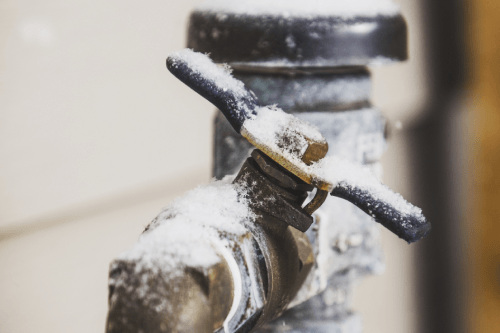We have unearthed this article about 6 Ways to Prevent Frozen Pipes below on the web and think it made good sense to relate it with you on this site.

Cold weather can wreak havoc on your pipes, especially by freezing pipes. Right here's how to avoid it from happening and what to do if it does.
Intro
As temperatures decline, the danger of icy pipes rises, potentially bring about costly repairs and water damages. Understanding exactly how to stop frozen pipes is vital for homeowners in chilly environments.
Understanding Frozen Pipes
What triggers pipelines to ice up?
Pipes ice up when subjected to temperature levels below 32 ° F (0 ° C) for extended durations. As water inside the pipelines ices up, it increases, putting pressure on the pipeline wall surfaces and possibly triggering them to rupture.
Dangers and damages
Frozen pipelines can lead to water disruptions, residential property damages, and costly repair services. Burst pipes can flooding homes and trigger considerable architectural damage.
Signs of Frozen Piping
Recognizing frozen pipelines early can avoid them from bursting.
Just how to recognize icy pipes
Look for lowered water flow from taps, unusual odors or sounds from pipes, and noticeable frost on revealed pipes.
Prevention Tips
Shielding susceptible pipelines
Wrap pipes in insulation sleeves or make use of heat tape to safeguard them from freezing temperature levels. Focus on pipelines in unheated or external areas of the home.
Home heating strategies
Maintain indoor rooms appropriately warmed, especially areas with pipes. Open up cupboard doors to permit cozy air to circulate around pipes under sinks.
Safeguarding Outside Plumbing
Garden pipes and outside faucets
Detach and drain pipes yard hose pipes before winter season. Set up frost-proof spigots or cover outdoor taps with insulated caps.
What to Do If Your Pipelines Freeze
Immediate actions to take
If you think icy pipes, maintain faucets open up to ease stress as the ice melts. Make use of a hairdryer or towels soaked in hot water to thaw pipes slowly.
Long-Term Solutions
Structural modifications
Think about rerouting pipes away from outside walls or unheated locations. Add added insulation to attics, cellars, and crawl spaces.
Upgrading insulation
Purchase high-grade insulation for pipes, attic rooms, and walls. Appropriate insulation aids maintain constant temperature levels and minimizes the threat of frozen pipes.
Verdict
Preventing icy pipelines calls for proactive steps and quick actions. By recognizing the causes, signs, and safety nets, homeowners can protect their plumbing during cold weather.
Helpful Tips to Prevent Frozen Pipes this Winter
UNDERSTANDING THE BASICS: WHY PIPES FREEZE AND WHY IT’S A PROBLEM
Water freezing inside pipes is common during the winter months, but understanding why pipes freeze, and the potential problems it can cause is crucial in preventing such incidents. This section will delve into the basics of why pipes freeze and the associated problems that may arise.
THE SCIENCE BEHIND FROZEN PIPES
When water reaches freezing temperatures, it undergoes a physical transformation and solidifies into ice. This expansion of water as it freezes is the primary reason pipes can burst. As the water inside the pipe freezes, it expands, creating immense pressure on the walls. If the pressure becomes too great, the pipe can crack or rupture, leading to leaks and water damage.
FACTORS THAT CONTRIBUTE TO PIPE FREEZING
Low Temperatures: Extremely cold weather, especially below freezing, increases the risk of pipes freezing. Uninsulated or Poorly Insulated Pipes: Pipes located in unheated areas, such as basements, crawl spaces, or attics, are more prone to freezing. Insufficient insulation or lack of insulation altogether exacerbates the problem. Exterior Wall Exposure: Pipes running along exterior walls are susceptible to freezing as they encounter colder temperatures outside. Lack of Heating or Temperature Regulation: Inadequate heating or inconsistent temperature control in your home can contribute to frozen pipes. PROBLEMS CAUSED BY FROZEN PIPES
- Pipe Bursting: As mentioned earlier, the expansion of water as it freezes can cause pipes to burst, resulting in significant water damage.
- Water Damage: When pipes burst, it can lead to flooding and water damage to your property, including walls, ceilings, flooring, and personal belongings.
- Structural Damage: Prolonged exposure to water from burst pipes can compromise the structural integrity of your home, leading to costly repairs.
- Mold and Mildew Growth: Excess moisture from water damage can create a favorable environment for mold and mildew growth, posing health risks to occupants.
- Disrupted Water Supply: Frozen pipes can also result in a complete or partial loss of water supply until the issue is resolved.
WHY CERTAIN PIPES ARE MORE PRONE TO FREEZING
- Location: Pipes located in unheated or poorly insulated areas, such as basements, crawl spaces, attics, or exterior walls, are at higher risk of freezing.
- Exterior Pipes: Outdoor pipes, such as those used for irrigation or exposed plumbing, are particularly vulnerable to freezing as they are directly exposed to the elements.
- Supply Lines: Pipes that carry water from the main water supply into your home, including the main water line, are critical to protect as freezing in these lines can affect your entire plumbing system.
- Underground Pipes: Pipes buried underground, such as those connected to sprinkler systems or outdoor faucets, can be susceptible to freezing if not properly insulated.
https://busybusy.com/blog/helpful-tips-to-prevent-frozen-pipes-this-winter/

I came across that blog post on Winter Plumbing Precautions: Preventing Frozen Pipes when doing research the search engines. Sharing is good. Helping others is fun. I love reading our article about Prevent Frozen Pipes .
Book Today